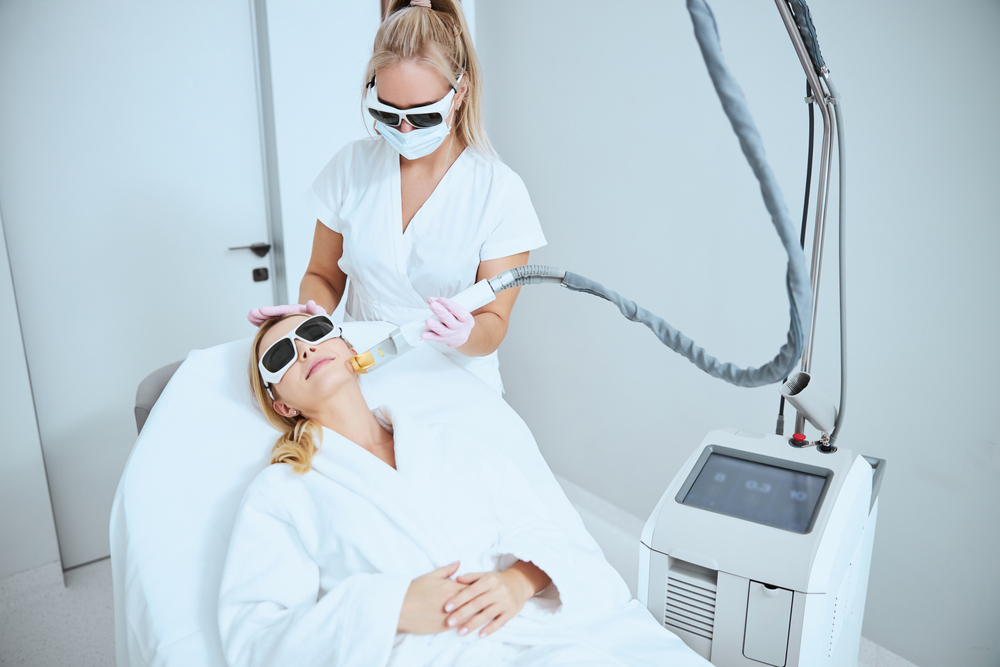When trying to combat the effects of aging, people are considering all the options available. Two popular treatments are RF microneedling and CO2 laser. Whereas both of them are great for reducing the effects of ageing, they are completely different treatments with different styles of operation.
Before choosing one or the other, you must know how they work. So, what are the main differences between RF and CO2? Let’s find out!
What Is RF Microneedling?
RD microneedling refers to a cosmetic procedure that uses fine needles and radiofrequency in order to trigger the skin’s production of elastin, capillaries, and collagen. This is done to help rejuvenate someone’s facial skin, reducing wrinkles and acne scars.
This is a minimally invasive procedure. The needles penetrate the skin gently, after which they use radiofrequency waves to cause some extra damage, enhancing the effects of the treatment.
RF microneedling is great in treating skin tightening, crepey neck skin, loose skin, stretch marks, facial wrinkles, decollete wrinkles, and acne scars.
What Is CO2 Laser Treatment?
CO2 laser resurfacing is a skin procedure where a skin surface-removing laser and carbon dioxide are used to reduce the aging effects. It removes the epidermis and heats the dermis. This way, it traumatizes the skin and stimulates the production of new collagen.
Afterwards, the epidermis will grow back and heal. As a result, it will have a much smoother, tighter, and clearer look.
CO2 laser skin resurfacing can be used to treat multiple aging effects, like age spots, sun-damaged skin, large pores, acne scars, fine and deep wrinkles, uneven skin texture or tone, and hyperpigmentation.
Ablative CO2 Laser vs. Fractional CO2
The very first laser that was created for cosmetic skin resurfacing was the CO2 laser. In the beginning, all treatments were ablative. Therefore, they treated the whole skin surface. This offered outstanding effects on the skin.
But as individuals experienced various side effects, fractional lasers started being developed. They work by creating an injury column, while the surrounding areas are untouched. This way, the untouched healthy skin could help the treated surface heal much faster. This would then decrease the risks of infection and scarring.
Of course, fractional CO2 laser treatments should be repeated as they do not offer results as quickly as ablative CO2 laser, but the effects are more natural and the risks are reduced significantly.
What Is the Difference Between RF and CO2?
Despite being used for the same things, the treatments are different. The main differences can be seen in:
- Therapeutic Action
Both treatments use heat to create certain therapeutic effects. Nevertheless, they have different ways of generating heat.
RF microneedling inserts tiny needles into the skin, after which it releases radiofrequency energy. On the other hand, CO2 lasers use light and convert it into heat energy.
- Treatment Depth
RF microneedling and CO2 laser skin resurfacing both have specific effects on the epidermis and dermis. However, the depth of the treatment is not the same.
As mentioned, RF microneedling uses small pins that are inserted into the skin. Once they penetrate the skin, radiofrequency energy is produced. The epidermis, which is the first skin layer, only deals with the pricks of the small needles. The dermis is the one dealing with the injury needed to break down damaged tissue and scars. This, of course, takes place at the tips of the needles.
The radiofrequency is the one creating injury, and it has to operate deeper in the dermis for efficiency. Therefore, RF microneedling can create a rather selective dermal response.
CO2 lasers, on the other hand, have more effect on the dermis. The lasers create controlled injury when they are applied to someone’s skin. This injury is made through the full skin thickness and in a thin column.
As such, it can help tighten the skin and contract collagen. However, what helps the skin heal and improve is the effect on the dermis.
Many people consider using a combination of RF microneedling and CO2 laser, and it can be beneficial for most people except for those who have darker skin tones. Although RF microneedling is safe for anyone regardless of the skin tone, CO2 laser is not great for individuals with darker skin. This is because it increases the hypo or hyperpigmentation risk.
- Contraindications
CO2 laser resurfacing is not recommended for people who have an active infection in the area they wish to treat. Furthermore, those who have used isotretinoin in the last six months should wait until they can receive this treatment.
With RF microneedling, the contraindications are different. People should refrain from it if they have active skin infections, severe inflammation, and active acne breakouts.
Final Thoughts
While RF microneedling and CO2 laser skin resurfacing are both incredible skin treatments, they work differently. You should know the differences so you can choose the right procedure based on your skin tone, problem, and skin condition.




